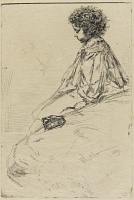Bibi Lalouette | ||
| Number: | 33 | |
| Date: | 1859 | |
| Medium: | etching and drypoint | |
| Size: | 227 x 151 mm | |
| Signed: | 'Whistler.' at lower right | |
| Inscribed: | '1859.' at lower right | |
| Set/Publication: | no | |
| No. of States: | 2 | |
| Known impressions: | 69 | |
| Catalogues: | K.51; M.51; T.30; W.30 | |
| Impressions taken from this plate (69) | ||
TECHNIQUE
It is mainly etched, with drypoint touches on head and hand.
PRINTING
A very large number of impressions, nearly seventy, are known, printed in black ink. It is very likely that less than half of these were printed by Whistler, and that the plate left his hands, possibly at the time of his bankruptcy in 1879, and was restored and reprinted.
An early impression of the first state is on cream Japan laid paper (). Later impressions are on a variety of papers, including Asian papers: ivory laid Japan (); cream Japanese (, , ); cream laid Japan (, ) thin off-white Japanese paper (); and ivory chine laid down on cream laid paper (). A scratched impression of the second state, dating from before 1883 when it was given to the Metropolitan Museum, is on thin dark ivory Japan ().
European papers include yellowed fibrous wove paper with grey-blue fibres () and possibly dark ivory wove paper () - these being impressions dating from before or in the early 1870s; and thin dark cream laid paper () - also an early impression. Other laid papers include ivory paper removed from a book with an 'IV' countermark (); dark cream laid (); and off-white 'Bouchet' watermarked paper (, ).
Restored impressions with the scratch are still in black ink, one on ivory Japan (), and off-white asian paper () and others on fine ivory laid (), ivory laid possibly taken from a book () and pale green laid paper (, ), the latter with a Beehive watermark. These may not have been printed by Whistler. There is a possibility that the plate had come into the hands of FrederickFrederick Keppel (1845-1912) of F. Keppel & Co., who may have arranged to have it very carefully restored and printed.
One extremely unusual impression was printed in black ink on dark tan silk/satin ()! This is almost certainly a later impression. It seems highly unlikely that Whistler would have printed on cloth, let alone this type.
Other late impressions, also probably printed posthumously, include impressions from the heavily inked and corroded plate on off-white wove paper () and thin off-white Japan (). A cancelled impression is on cream wove paper ().
